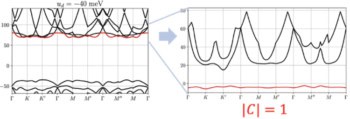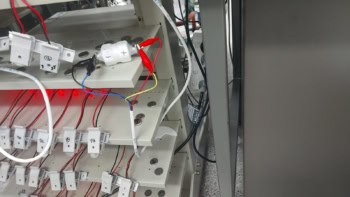
Two-dimensional sheets of boron nitride can be used to create an analogue switch that gives communication devices more efficient access to radio, 5G and terahertz frequencies while increasing their battery life. The switch, which was developed by a team of researchers at the University of Texas at Austin in the US and the University of Lille in France, could be employed in a host of different applications, including smartphones, mobile systems and the “Internet of things”.
Analogue switches are routinely employed in communication systems to switch from one frequency band to another, route signals between transmitting and receiving antennas, and reconfigure wireless networks. Traditionally, these switches are based on solid-state diodes or transistors, but components of this type consume energy even in standby mode, reducing the battery life of the device. With 5G networking set to drive a tenfold increase in data throughput – enabling advances in self-driving cars, delivery drones, remote surgery and fast downloads of high-definition media in the process – addressing this energy drain is more urgent than ever.
“White graphene”
A team led by Deji Akinwande of UT Austin’s Cockrell School of Engineering has now made an analogue switch from atomically thin sheets of hexagonal boron nitride (hBN). This material belongs to the same family as graphene (indeed, it is sometimes called “white graphene” for its resemblance to sheets of one-atomic-layer-thick carbon) and comprises a single layer of boron and nitrogen arranged in a honeycomb pattern. The material’s unusual electronic properties – including a large bandgap and high phonon energies – make it an excellent dielectric, and Akinwande and colleagues used it to construct a switch that is 50 times more energy-efficient than existing commercial alternatives.
The device is configured in a metal-insulator-metal sandwich on a diamond substrate, and the UT team demonstrated that it can transmit multiple HDTV streams at a frequency of 100 GHz – something unheard-of in broadband switch technology, Akinwande says. It can also switch between states in nanoseconds, remain in the “off” state when not operating (so saving battery life), and transmit data well above the baseline for 5G-level speeds.
Building on previous work
While researchers have made near-zero-power switches before, these other devices were limited to the low end of the 5G spectrum, where speeds are slower but data can travel longer distances. Akinwande and colleagues’ switch is the first to function from low-end GHz frequencies to high-end THz frequencies – something that might one day be key to developing 5G’s successor, 6G.

Navigating the terahertz gap
As well as saving battery life in smartphones, the switch could also be used in satellite systems, smart radios, reconfigurable communications, the Internet of things and defence technology, according to the researchers.
The present work, which is detailed in Nature Electronics, builds on previous work by Akinwande’s team in which they created the thinnest ever memory device from hBN. In the future, they plan to improve the reliability of their switches to millions of cycles and push the technology to work at the higher speeds required for 6G wireless applications. Akinwande has also published a blog post about the work on the Nature Research Communities website.



